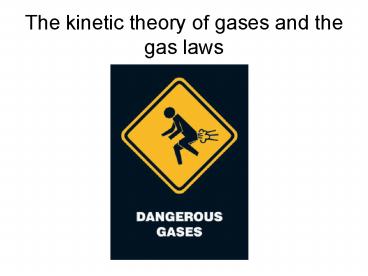The kinetic theory of gases and the gas laws - PowerPoint PPT Presentation
1 / 19
Title:
The kinetic theory of gases and the gas laws
Description:
The kinetic theory of gases and the gas laws * * * Kinetic theory/ideal gas We can understand the behaviour of gases using a very simple model, that of an ideal ... – PowerPoint PPT presentation
Number of Views:519
Avg rating:3.0/5.0
Title: The kinetic theory of gases and the gas laws
1
The kinetic theory of gases and the gas laws
2
Kinetic theory/ideal gas
- We can understand the behaviour of gases using a
very simple model, that of an ideal gas. - The model makes a few simple assumptions
3
Ideal gas assumptions
- The particles of gas (atoms or molecules) obey
Newtons laws of motion.
You should know these by now!
4
Ideal gas assumptions
- The particles in a gas move with a range of speeds
5
Ideal gas assumptions
- The volume of the individual gas particles is
very small compared to the volume of the gas
6
Ideal gas assumptions
- The collisions between the particles and the
walls of the container and between the particles
themselves are elastic (no kinetic energy lost)
7
Ideal gas assumptions
- There are no forces between the particles (except
when colliding). This means that the particles
only have kinetic energy (no potential)
Do you remember what internal energy is?
8
Ideal gas assumptions
- The duration of a collision is small compared to
the time between collisions.
9
Pressure A reminder
- Pressure is defined as the normal (perpendiculr)
force per unit area - P F/A
- It is measured in Pascals, Pa (N.m-2)
10
Pressure A reminder
- What is origin of the pressure of a gas?
11
Pressure A reminder
- Collisions of the gas particles with the side of
a container give rise to a force, which averaged
of billions of collisions per second
macroscopically is measured as the pressure of
the gas
Change of momentum
12
Explaining the behaviour of gaseshttp//phet.colo
rado.edu/sims/ideal-gas/gas-properties.jnlp
- When we heat a gas at constant volume, the
pressure increases. Why?
13
Explaining the behaviour of gases
- When we heat a gas at constant volume, the
pressure increases. Why? - Increased average kinetic energy of the
particles means there are more collisions with
the container walls in a period of time and the
collisions involve a greater change in momentum.
14
Explaing the behaviour of gases
- When we heat a gas a constant pressure, the
volume increases. Why?
15
Explaing the behaviour of gases
- When we heat a gas a constant pressure, the
volume increases. Why? - Increasing the volume reduces the chance of
particles colliding with the container walls,
opposing the effect of the particles increased
kinetic energy.
16
Explaing the behaviour of gases
- When we compress (reduce the volume) a gas at
constant temperature, the pressure increases. Why?
17
Explaing the behaviour of gases
- When we compress (reduce the volume) a gas at
constant temperature, the pressure increases.
Why? - A smaller volume increases the likelihood of a
particle colliding with the container walls.
18
Explaing the behaviour of gases
- In this way we are explaining the macroscopic
behaviour of a gas (the quantities that can be
measured like temperature, pressure and volume)
by looking at its microscopic behaviour (how the
individual particles move)
19
The Gas Laws
- There are mathematical relationships between
pressure, volume and temperature of a gas (at a
fixed mass). - We will study these next year at higher level!































